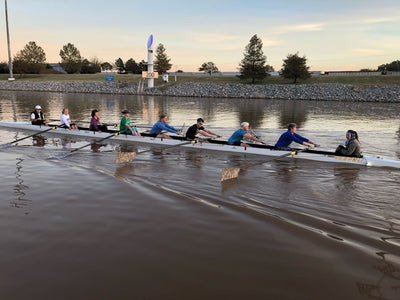
In the rowing world, there are two types of rowing. Sculling involves two oars, one for each of your hands, and sweeping involves one oar that both of your hands will hang on to. Sweeping has deep roots in world history, dating back to Viking and Greek war ships, which were powered by men who sat side by side each other. In order to move those ships, the men would have to work collaboratively to establish an efficient rhythm. This type of rowing formed the foundation for today’s modern Olympic sport of sweep rowing.
As rowing evolved and became a sport, the boats narrowed in width. The more slim a hull is, the greater its chances of going fast. The men who had once sat side by side, now sat in a long line, their backs to the bow of the boat.
Recently, The Boys in the Boat, was written about the American Olympic rowing team who traveled to Nazi Germany in 1936 and went on to win the gold medal. The book reignited interest in the sport and put a spotlight on sweep rowing.
But sweep rowing isn’t just for Olympians, it’s for everyone. Many boathouses across the country offer learn to row programs for teens and adults to matriculate into rowing for the first time. There are three main types of sweep boats:
- A 2- or a Pair: This boat is smaller and is rowed by two people with one oar each. There is typically no coxswain.
- A 4+- or a Four: This boat seats four people who each have one oar. It can be rowed with or without a coxswain. If it is rowed without a coxswain, it is referred to as a straight four.
- An 8+ is the largest and most notably popular boat, featured in the main events at Olympic, Collegiate, Masters and Juniors races.
Learning the basics of sweep rowing can be confusing at first, but with a little patience and a good coach, you can be enjoying the water in no time. One of the best parts about sweep rowing is the team aspect. Sweep rowing cannot be done alone, you have to have at least one other person to join you. There is nothing like the harmony you find within teamwork.
Sweep rowing is built around the same principles as sculling and erging (indoor rowing). There are three basic movements to the stroke. Most beginning rowers start from the finish position, with the legs flat and the back slightly open, hands into to the chest. The first thing you do is slightly tap your hands down, and move them forward. The tap down is to get the blade on the end of the oar clear from the surface of the water. The next step is to move your body angle forward, from the hips. The blade will stay tapped down out of the water. Finally, you will break your knees and slide up to the catch position.
At the catch position you will keep your arms straight in front of you and slightly raise your hands until your blade enters the water. Then all of the movements reverse. With the blade in the water, you’ll push back with your legs. Once your legs are flat, you’ll swing the body and finally finish by pulling in with the arms to the chest.
Sweep rowing has an abundance of health benefits. If the correct technique is utilized, it is one of the only complete and total body workouts, free from aggressive and damaging impact found in most competitive sports. In addition to being a complete workout for your body, it also improves flexibility and can be good for sharpening your mind as well. Be sure to grab some Super Blue Stuff OTC, an all-natural pain relief cream that you can use to alleviate sore muscles before and after your workout!
It takes time and patience to hone the skill of sweep rowing. Because it is done with more than just one person it can be difficult to get the hang of. But with dedication and a lot of practice, you can master the sport of sweep rowing in no time!


 {{/image.src}}
{{/image.src}}





